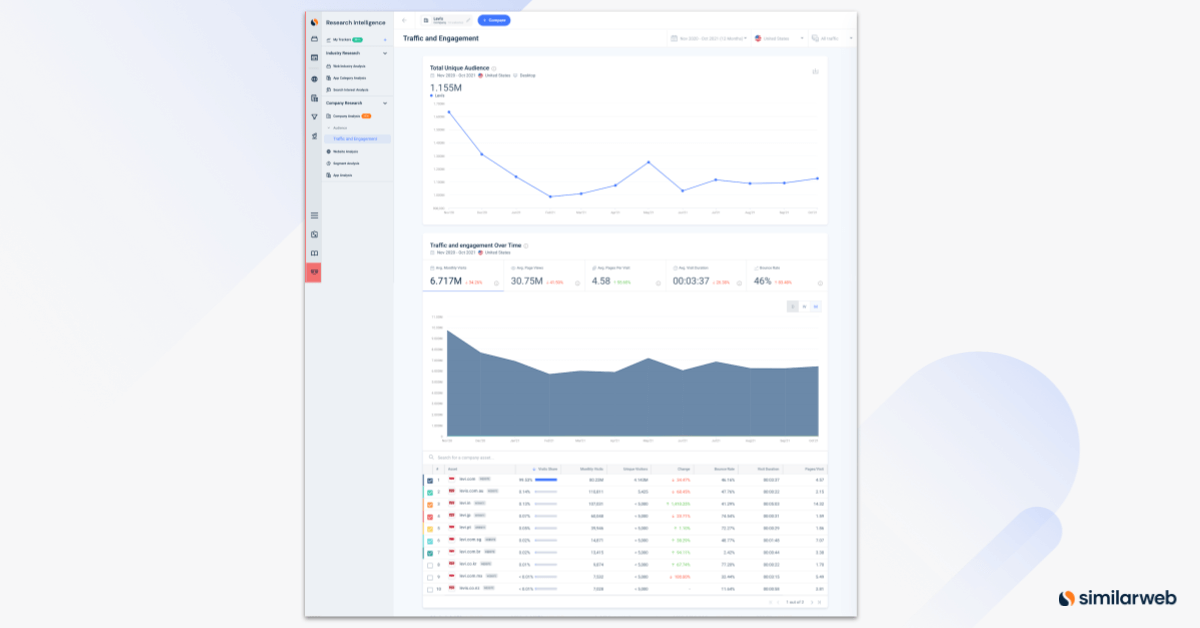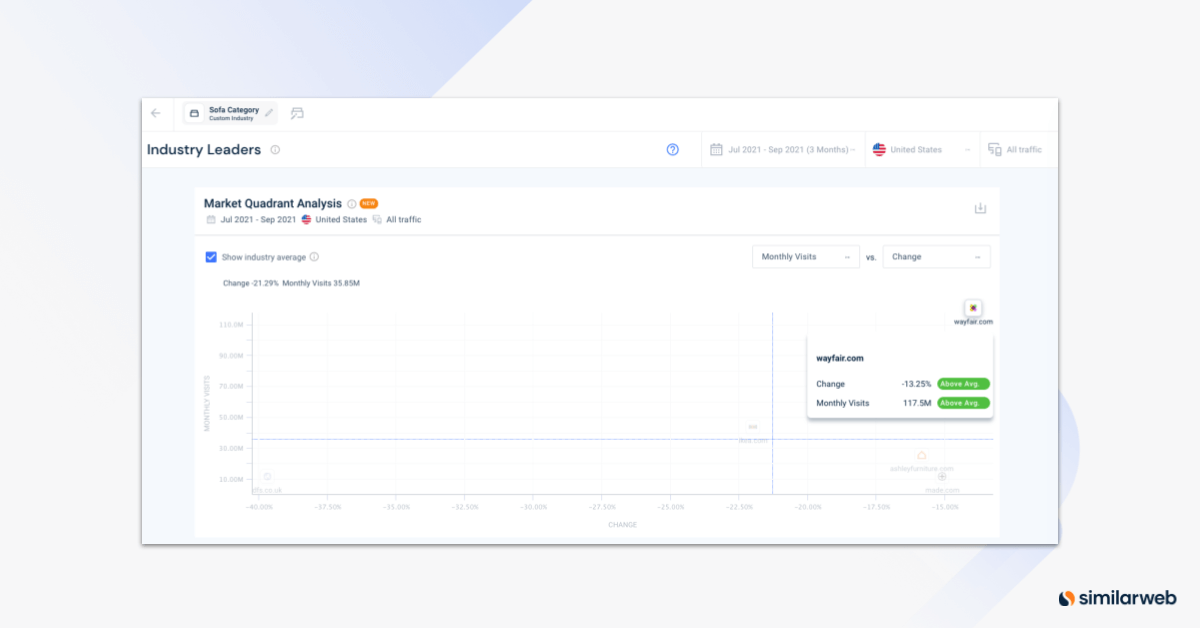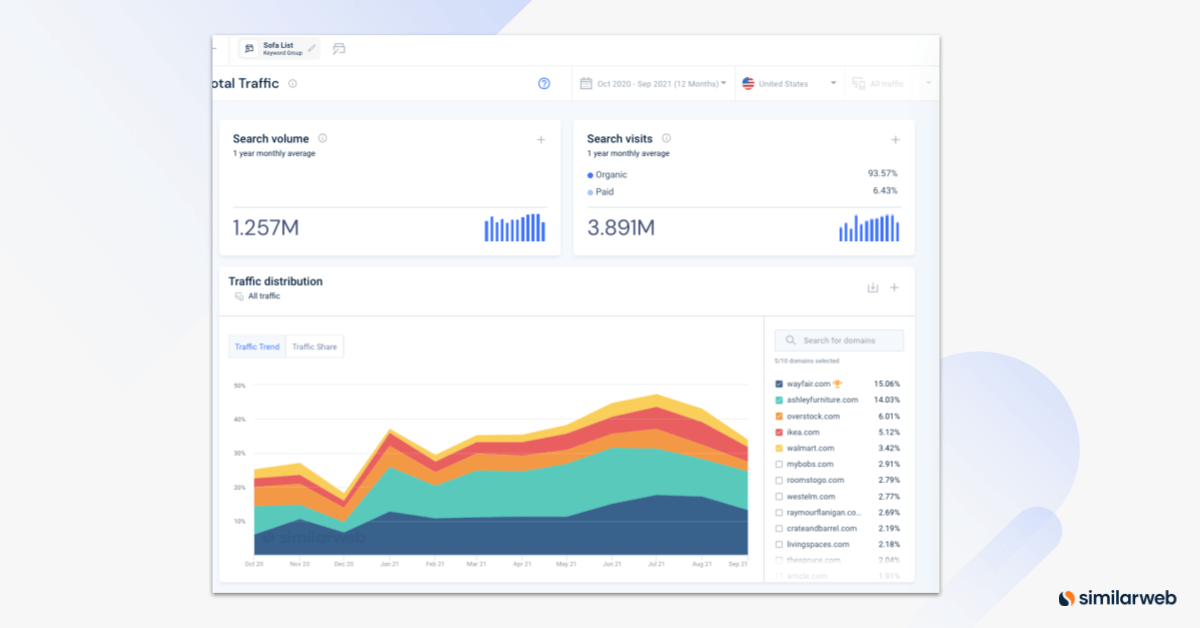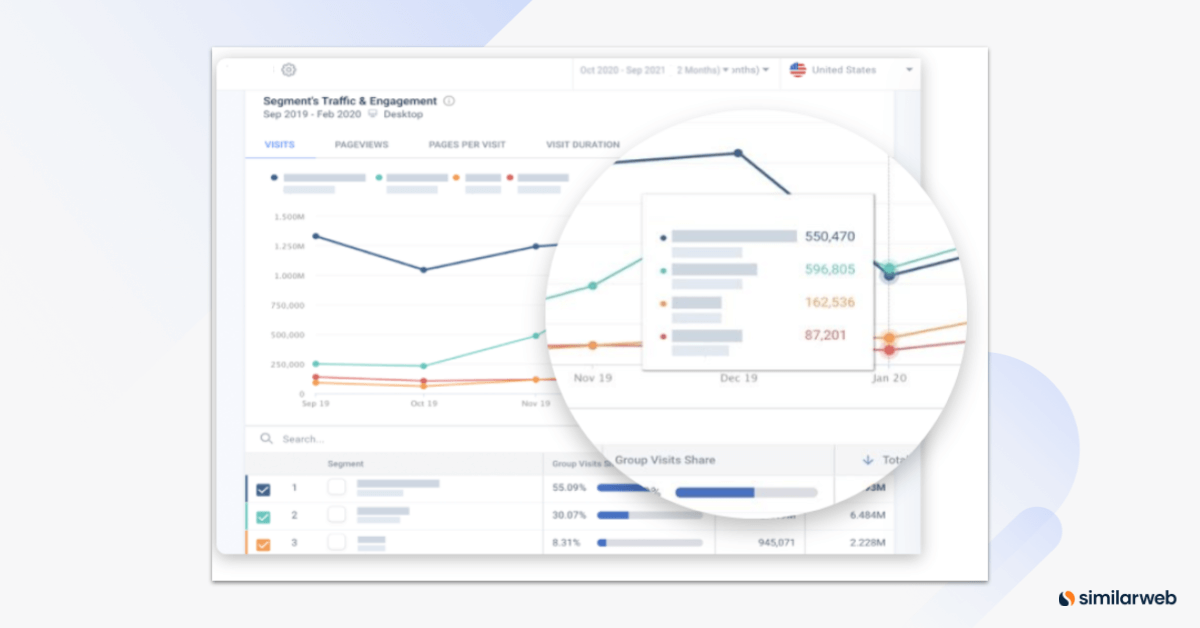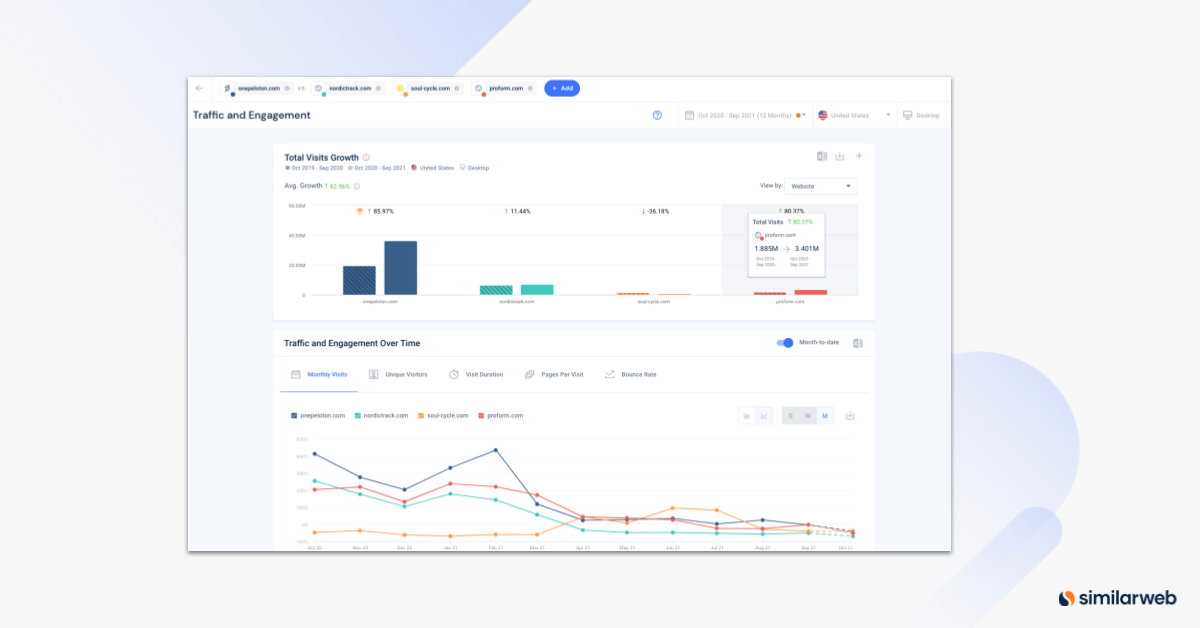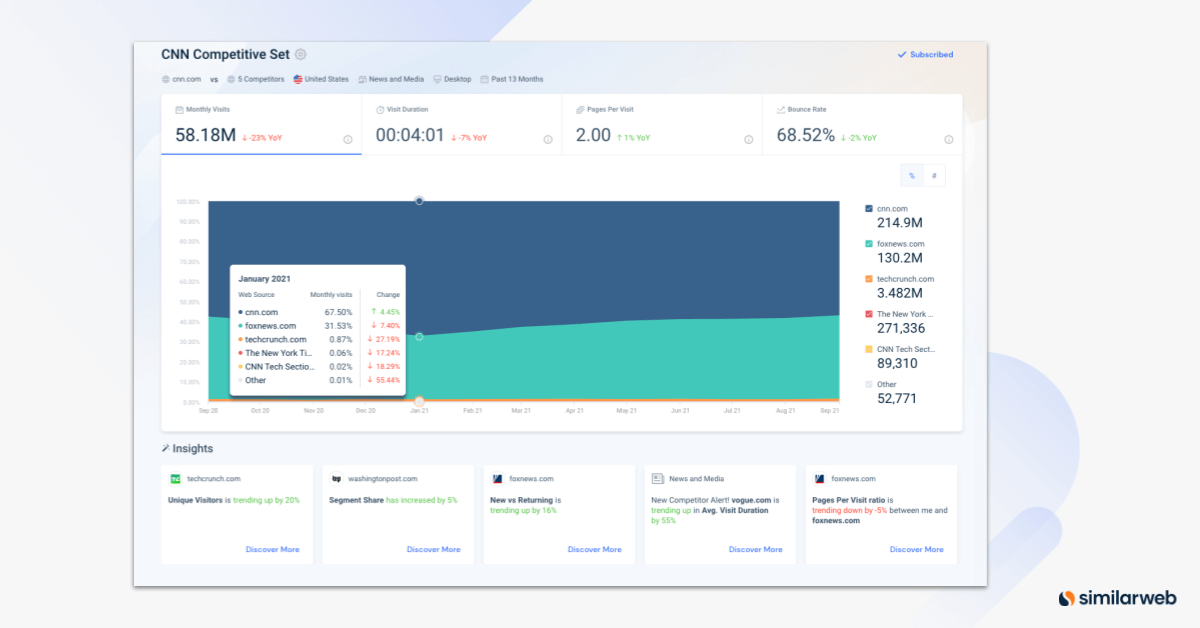3 Competitive Analysis Examples & Use Cases

Competitive analysis does more than evaluate your business’s performance and strategies. Effective competitor analysis provides the context you need to grow your share.
We have a whole list of examples where competitor analysis was used to increase traffic share, market share, or share of voice or wallet. But, for each competitive analysis example, there are probably five attempts to initiate growth that fell flat. The reason is usually insufficient insights into competitor activities or industry trends.
It’s a big topic with plenty of possibilities. Sometimes the best way to wrap your head around it is by looking at an example. In this article, we’ll take you step by step through a real-life competitive analysis example.
When is competitive analysis important?
If your first thought was GTM (Go-To-Market), you’re right; it’s one example where competition analysis is critical. We’ve covered that in our competitive analysis guide, where you also get a nifty competitive analysis template.
But let’s – just this one time – not think that big. Competitive analysis should be part of an analyst’s routine, even when a company is established in a market.
A competitive market analysis is a tool for everyday use to identify trends, opportunities, and threats right at the start.
Once you gain these insights, you can adapt marketing campaigns and business strategies, and optimize them to meet new challenges. Knowing what competitors are up to helps counter their efforts to outcompete you.
Competitor analysis tools allow you to be a step ahead. Instead of reacting to changes in the market as they happen, you prepare yourself, welcome them with open arms, and use them to your advantage.
3 use case examples of competitive analysis
In our experience, people love theoretical step-by-step guides. The problem is, they never seem to find the right use case to implement what they learned. Not that there aren’t any, but matching theory and practice isn’t simple.
So, here are a few use cases before we walk you through a full-blown competitive market analysis example.
- There are few competitors in your small market niche. Competitors are very similar – they offer the same product features and price level, and they target the same audience. Websites look similar, and they use identical marketing channels.How can you stand out and create an advantage for yourself? This scenario is an example of when to do a competitor analysis to get a granular view. The idea is to find minute differences and identify consumer trends.
- There’s a newcomer in the market making a lot of noise and grabbing a lot of attention. Is the new company all style and no substance? It’s up to you to figure out how serious of a threat they really are. Ask yourself: Is this company offering something that disrupts the market? Could it steal your wallet share, or is it just creating buzz?
- You have a stable product line and a stable customer base. The company is profitable and growing; everything is business as usual.Why would you want to invest in competitive market analysis at this time? Because that’s exactly the time when the competition is doing everything to find and exploit your weak spots.
You need to be aware of their schemes. Maybe it’s time for you to come up with something new? Attract a different audience?
Step-by-step example of a competitive market analysis
Now let’s see it in action. Here’s how one analyst created a competitive analysis that helped him identify and capitalize on the most profitable business lines for his company.
It all began with an email from senior management – a bad start. Steve, an analyst at a respected and successful homeware store, was asked if the downward trend in sofa sales should be a reason for concern and action.
It’s one of those typical management questions – very generic but addressing a highly specific issue. Of course, you can’t answer off the top of your head. You need data. And not just any data, but data that enables you to calm or alarm management (and stay out of trouble).
So, here’s what Steve did:
1. Identify the main competitors and analyze their digital footprint.
He investigated overall traffic and engagement metrics, i.e., unique visitors for the top competitors. He then benchmarked his company’s numbers against them.
Steve also looked at subdomains to view their strongest pages or product categories. In this example, he discovered a competitor with significant growth in all but one domain.
Nothing about sofa sales yet, but worthwhile noticing this competitor and keeping an eye on them.
2. Identify the market leader and everyone’s position in the market.
Steve wanted to know exactly where his brand stands relative to the competition.
He used a grid view to discover how different metrics are related, for example, traffic volume vs. engagement level. Plotting them in a competitive matrix provided a visual of how the various competitors were doing.
But what he really wanted to see were the changes. To do this, he used an MoM metric to identify trends and then compared monthly visits vs. % MoM change on the grid view.
This gave him a clear view of who was gaining traffic and engagement and how much.
3. Understand audience preferences and search behavior.
In this step, Steve moved his attention toward the audience. By analyzing search interests, he gained insights into the demand for sofas. He could measure the overall market trend and discover additional competitors he hadn’t considered before by looking at the distribution of the share.
Steve measured a search volume of 1.257 million for sofa-related search terms. He also segmented the website traffic by competitors to discover how the traffic was distributed.
Now each competitor’s current digital market share was easy to grasp.
4. Zoom in on the sofa segment.
By now, Steve had a thorough understanding of the competitive digital landscape in the industry. But he needed more granularity to provide answers about a specific product line.
So next, Steve broke down his competitors’ website traffic by website segment and pages. This helped him analyze the performance of sofa category pages, compare, and see who’s winning traffic share.
While doing this, Steve realized that he could also identify the level of profitability for the various product lines and provide his superiors with additional valuable information.
5. Discover who’s driving the trend.
Steve needed to understand the trends in more detail. Identifying which competitor’s traffic share had grown more significantly than that of others would give him an indication of who’s grabbing wallet share from his company.
He analyzed the YoY changes and discovered one competitor who increased traffic by 80% –5% more than his company.
Bingo! Steve had uncovered where the challenge might potentially be rooted. Now he could deep-dive into this company’s metrics to understand how and why this was happening.
His goal was to figure out what caused the surge and provide the marketing and product teams with insights that could help them find ways to level the playing field or trump competitors.
A competitive analysis example to learn from
Our hero provided senior management with valuable insights based on systematic data analysis. Thanks to Steve, his company was able to quickly adapt digital strategies, knowing precisely what it was up against and where the threat was coming from.
Not only that, but Steve also discovered a newcomer in the market and pinpointed a particularly fast-growing brand that had the potential to turn into a threat. Additionally, he could present information about the most profitable product categories. Nicely done, Steve!
Here’s what Steve has learned from the experience: Using reliable and comprehensive data sets and metrics is the key to quickly uncovering changes, threats, and opportunities.
In the future, he won’t wait until he gets an email from the boss. From now on, he’ll continuously track competitors. Next time, he’ll be the one to raise the flag and also have the relevant data available to point toward a solution.
What did we learn?
Don’t be like Steve. Be proactive. Sure, you can apply a competitive analysis when you encounter one of the scenarios that leave you no choice. But you’ll be better off continuously analyzing your competition, starting now.
Markets are like never-ending playoffs. You’re either fighting to gain market share or struggling to win back the share your rivals snatched from you. With insights into your competitors’ weaknesses and soft spots, you gain an advantage.
Similarweb provides the digital intelligence that helps you stand your ground and outperform the competition. Contact us today and get a product demo.
FAQs
What is an example of competitive analysis?
Basically, any time you actively seek your competitive advantage or the rivals’ disadvantage, you conduct a competitive analysis. In business, this can be a comprehensive project involving several business units or a daily routine.
How do you do a competition analysis?
The first step of a competitive analysis is to identify the top competitors. Next, collect data that allows you to evaluate strengths, weaknesses, trends, changes, risks, and advantages. Finally, compare the data and performance of your company to the various competitors.
What should a competitive analysis include?
A competitive analysis should cover four main areas: the company, audience, products and prices, and marketing. Depending on the character of the market or your business goal, you can prioritize or add additional areas to analyze.
Should you use a competitive analysis template?
A competitive analysis template is very helpful because it allows you to conduct the same analysis for many markets. You can conduct an ad-hoc analysis, and track and monitor the market environment over time.
Sources
Get ahead of game-changing consumer trends
Contact us to set up a call with a market research specialist

